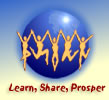Twelve Ways to Improve Your Estimating Accuracy (Part 3)
by Adele Sommers
Once you develop robust estimating techniques, why not institutionalize them? The benefits to your organization could be enormous. In addition to reducing project risks, standardized practices also help ensure smooth sailing through the roughest estimating situations, enable you to respond gracefully to unexpected circumstances, and streamline the entire process for future undertakings.
Part 1 and Part 2 of this series covered the first eight tips for increasing estimating accuracy:
1. Maintain an estimating and "actual hours" database.
2. Create project planning documents.
3. Perform a detailed task analysis.
4. Use a "complexity factor" to compare two sets of project tasks.
5. Use more than one method to arrive at an estimate.
6. Document caveats, constraints, and assumptions in your estimate.
7. Propose adjusting the "project diamond" criteria.
8. Consider alternative ways of performing the work.
This article (Part 3) delivers four final tips on anticipating project needs, creating contingency plans, and developing more sustainable estimating methods.
9. Plan and estimate the project rollout at the beginning.
 The project rollout is the "rubber-meets-the-road" implementation of whatever your project is going to deliver. A smooth rollout strives to minimize the disruption of business activity. In so doing, it aims to avoid crises such as a system failure or an overload on the people who must begin using the project deliverables. The project rollout is the "rubber-meets-the-road" implementation of whatever your project is going to deliver. A smooth rollout strives to minimize the disruption of business activity. In so doing, it aims to avoid crises such as a system failure or an overload on the people who must begin using the project deliverables.
Planning for the release of project deliverables should start in the pre-proposal, estimating phase.
That's when people can proactively envision the possibilities for addressing downstream needs, instead of simply allowing circumstances to dictate their options later.
The considerations on the Tips for Smoothly Rolling Out Projects checklist suggest strategies you can use to plan smooth rollouts. You can then identify, propose, and estimate your rollout activities accordingly.
10. In really nebulous situations, try phase-based estimating.
If you're trying to muddle your way through a very open-ended and vague set of requirements -- where the margin for estimating error seems enormous -- you could propose to do the work in phases.
You can designate the very first phase specifically for gathering and analyzing the project requirements. This discovery phase can be particularly important if you need to interpret detailed specifications, understand complex technologies, and/or master a new vocabulary to complete the work.
 As part of the first phase, you could offer to deliver a detailed estimate for one or more subsequent phases, and perhaps a prototype, outline, plan, or analysis that represents or describes future work. While in this discovery mode, actually rolling up your sleeves and creating specific work samples might be the most realistic way to estimate the remaining development. As part of the first phase, you could offer to deliver a detailed estimate for one or more subsequent phases, and perhaps a prototype, outline, plan, or analysis that represents or describes future work. While in this discovery mode, actually rolling up your sleeves and creating specific work samples might be the most realistic way to estimate the remaining development.
Phase-based estimating can thus enable you to pursue a complex project without backing yourself into a corner.
If your clients agree to an initial needs assessment phase -- with no assumptions about the outcome -- you'll have more latitude to explore the possibilities, prepare a project plan, and develop a proposal. The clients also benefit because they'll see the caliber of your work without having to commit to the entire project. It's a win-win way to mitigate risk!
11. Develop contingency plans by prioritizing the effort from the start.
Contingency plans are any predefined remedies or fallback plans that you develop based on "what if" scenarios. Such plans would spring into action if a project were in danger of falling short in any area in which success will be measured. Below is one of my favorite approaches.
Propose prioritizing all deliverables using whatever method all stakeholders can agree on. For example, the highest priority items would probably include features and functions that would be needed most frequently, or that would produce the most critical impacts if they were missing.
Especially on a fixed budget or schedule, try to ensure that all stakeholders concur early that the lower-priority items can be scaled back or removed if the project becomes bogged down by unpredictable events. If it turns out that the pacing factor is something beyond the team's control -- such as the limited availability of certain key players or resources -- then the whole schedule might need to be rearranged to accommodate these constraints.
 With a contingency plan in place, however, all work can proceed in priority order. Here's a simple but effective strategy for
applying this sanity-saving approach: With a contingency plan in place, however, all work can proceed in priority order. Here's a simple but effective strategy for
applying this sanity-saving approach:
a. Review and organize all tasks or deliverables into these categories:
- "Must-have" within the current
schedule, because they will be frequently used or high-impact items
- "Nice-to-have" within the current
schedule, but could be postponed
- Can't even schedule until there is more information available
b. Also, determine in advance whether the stakeholders would consider, in the event of a schedule crunch, receiving delivery:
- In phases, just in time for the deliverables' first dates of actual use
- As a pilot or series of prototypes to be tested first and refined later
Therefore, if problems or delays arise, you and your client, management, and the project stakeholders will already have a flexible understanding of the priorities to be fulfilled -- as well as any tasks or deliverables that might need to be jettisoned or deferred if the project runs out of time or budget.
12. Refer to your "lessons learned" database for 20:20 foresight.
Whenever you can tap insights you've gained from past experience, they'll help you create more accurate estimates because you'll be transforming "20:20 hindsight" into "20:20 foresight."
 In this area, the Tips for Capturing "Lessons Learned" checklist suggests what to document over time, such as workarounds, solutions to problems, and preventative measures (including templates and checklists). In this area, the Tips for Capturing "Lessons Learned" checklist suggests what to document over time, such as workarounds, solutions to problems, and preventative measures (including templates and checklists).
Develop "best practices" to aid future estimating. Best practices are the very best ways that you and your organization have found of performing various tasks.
By documenting best practices for your work processes, you can "plug them in" and estimate them in a consistent way each time. Consequently, future task analyses will automatically account for the most easily overlooked project activities, such as reviews, revisions, and testing.
In conclusion, by planning your project rollouts proactively, using phase-based estimating, developing contingency plans, and repeatedly capturing your lessons learned and best practices, you'll dramatically improve your estimating success!
Copyright 2011 Adele Sommers
|


